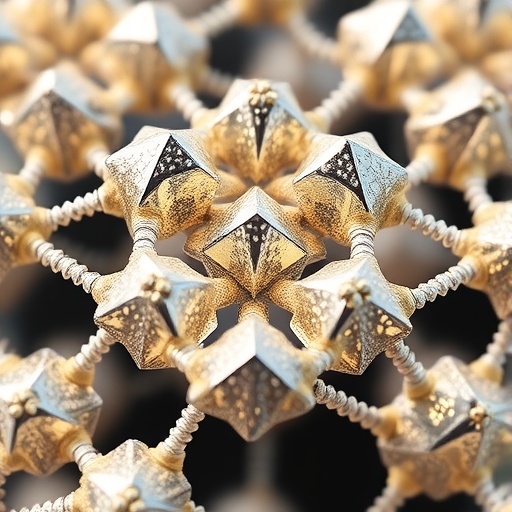In the dynamic field of materials science, the synthesis of nanocomposites has gained significant interest, particularly in the context of enhancing photocatalytic and energy storage applications. A new study led by Nesavi, Balu, and Pavai unveiled a breakthrough in this area, presenting a novel approach for the hydrothermal synthesis of heterostructured CuO/SnO₂ nanocomposites. This innovative method not only paves the way for the development of efficient photocatalysts but also elevates the performance of supercapacitors, making it a noteworthy advancement in nanotechnology.
The hydrothermal synthesis method utilized in this research represents a pivotal shift in how nanocomposites can be fabricated. By employing a controlled-temperature and pressure environment, this technique enables the growth of nanostructures with precise morphology and composition. In the case of the CuO/SnO₂ heterostructures, the synthesis process allows for the fine-tuning of the interfacial properties between the two materials, which is crucial for optimizing their photocatalytic and electrochemical performances.
One of the most remarkable characteristics of the heterostructured CuO/SnO₂ nanocomposites is their ability to effectively degrade organic pollutants under UV light. Photocatalytic degradation is an essential process in environmental remediation, particularly for removing contaminants from water sources. The unique properties arising from the interaction between CuO and SnO₂ facilitate a more efficient charge separation and transfer process, resulting in higher photocatalytic activity compared to their pristine counterparts.
Moreover, the research highlights the dual functionality of the CuO/SnO₂ nanocomposites, expanding their application beyond just photocatalysis. The integration of these materials into supercapacitor systems demonstrates their excellent energy storage capabilities. Supercapacitors, known for their rapid charge and discharge cycles, are vital in various applications, from renewable energy systems to electric vehicles. The study showcases that the CuO/SnO₂ nanocomposites exhibit significant specific capacitance, enhancing the performance of supercapacitor devices.
Another aspect of this groundbreaking research is the in-depth characterization of the synthesized nanocomposites. Utilizing advanced techniques such as X-ray diffraction (XRD), scanning electron microscopy (SEM), and transmission electron microscopy (TEM), the authors meticulously analyzed the structural and morphological properties of the materials. This comprehensive characterization is crucial for correlating the synthesis parameters with the resulting material properties, ultimately enabling the optimization of further applications.
The researchers also performed electrochemical assessments to evaluate the supercapacitor performance of the CuO/SnO₂ nanocomposites. The charge-discharge tests, alongside cyclic voltammetry, confirmed that these materials possess high electrical conductivity and excellent cycling stability. The findings suggest that these nanocomposites can be integrated into existing energy storage technologies, potentially leading to the development of next-generation supercapacitors with enhanced performance metrics.
Additionally, the study delves into the potential mechanisms behind the observed photocatalytic activity and energy storage capabilities. Understanding these mechanisms is vital for the design of future nanocomposite structures that can maximize efficiency and functionality. The research indicates that the synergistic effect occurring at the interface of CuO and SnO₂ plays a fundamental role in promoting electron-hole pair generation, which is essential for photocatalytic reactions and charge storage processes.
As environmental concerns continue to mount, the significance of developing advanced photocatalytic materials cannot be overstated. This study presents a promising solution that not only addresses water pollution but also contributes to sustainable energy solutions. The ability of CuO/SnO₂ nanocomposites to simultaneously tackle these two critical issues highlights their versatility and relevance in today’s scientific landscape.
Moreover, the implications of this research extend beyond merely providing new materials. The methodology developed for synthesizing these heterostructured nanocomposites lays a foundation for future investigations into other combinations of metal oxides and their applications. By varying the compositions and structures, researchers may unlock a plethora of material properties, fostering advancements across numerous fields, including catalysis, energy storage, and electronic devices.
The attention drawn by this study is expected to inspire other scientists in the materials science domain to explore the potential of heterostructured nanocomposites. Collaborative efforts and further research are essential for translating these findings from laboratory settings to practical applications in industrial processes, environmental management, and energy systems. Integrating these novel materials into real-world solutions could lead to impactful improvements in both environmental sustainability and energy efficiency.
In conclusion, the hydrothermal synthesis of CuO/SnO₂ nanocomposites presents a significant advancement in materials science, offering dual solutions for photocatalytic degradation and energy storage. As researchers continue to explore and optimize these materials, the potential for practical applications in combating pollution and enhancing energy systems becomes increasingly promising. This study not only showcases the capabilities of nanocomposites but also emphasizes the need for innovative approaches in material synthesis that can address the pressing challenges of our time.
In summary, the research conducted by Nesavi, Balu, and Pavai exemplifies the cutting-edge role of nanocomposites in modern science. Through meticulous experimentation and characterization, the development of CuO/SnO₂ heterostructures proves to be a milestone in enhancing photocatalytic and supercapacitor technologies. The implications of this work promise to resonate across multiple scientific disciplines, reaffirming the pivotal importance of nanotechnology in shaping a sustainable future.
Subject of Research: Hydrothermal synthesis of CuO/SnO₂ nanocomposites and their applications in photocatalysis and supercapacitors.
Article Title: Hydrothermal synthesis of heterostructured CuO/SnO₂ nanocomposites for photocatalytic degradation and supercapacitor applications.
Article References:
Nesavi, T., Balu, L. & Pavai, R.E. Hydrothermal synthesis of heterostructured CuO/SnO₂ nanocomposites for photocatalytic degradation and supercapacitor applications.
Ionics (2025). https://doi.org/10.1007/s11581-025-06697-0
Image Credits: AI Generated
DOI: https://doi.org/10.1007/s11581-025-06697-0
Keywords: Nanocomposite, Hydrothermal synthesis, Photocatalytic degradation, Supercapacitor, CuO, SnO₂, Nanotechnology, Environmental remediation, Energy storage.
Tags: advanced nanotechnology applicationsCuO/SnO₂ nanocompositesenergy storage applicationsenvironmental remediation technologiesheterostructured nanomaterialshydrothermal synthesis of nanocompositesinterfacial properties optimization in compositesmaterials science innovationsorganic pollutant degradation under UV lightphotocatalytic performance enhancementprecise morphology control in nanomaterialssupercapacitor efficiency improvement





